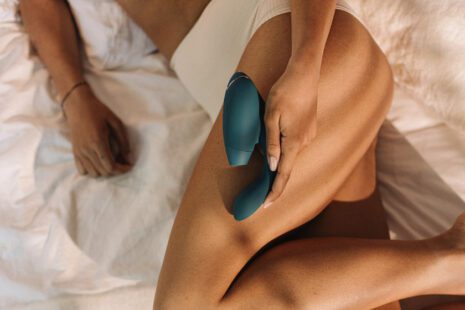Understanding the G-Spot
The origin of the G-Spot, its location, and how to unlock it as a source of orgasm, empowerment and self-knowing.
Frequently regarded as a key to intense orgasms, the G-Spot intrigues many of us. What is it? Where is it? How to get to it?
“G-Spot” is short for Gräfenberg spot, named after German gynecologist Ernst Gräfenberg who studied the role of the urethra in female orgasms through the 1950s. (He also developed precursors to modern day IUDs – yay for birth control!)1 The G-Spot is an erogenous area believed to be roughly 2-3 inches inside the front wall of the vagina. We understand it to be a combination of nerve endings, glands, and erectile tissue, which can make it very sensitive and pleasurable area when stimulated.
Location and Exploration
Triangulating the G-Spot can be a fascinating and intimate partnered or solo journey. Since everyone is anatomically unique, the exact spot varies from person to person, however the G-Spot is generally found along the front wall of the vagina, about 2-3 inches in from the opening.2 Hint: the G-spot typically feels slightly rougher or ridged compared to surrounding tissue.
To explore this or any erogenous zone, it’s essential to develop trust, open communication, and establish consent. It isn’t just blindly feeling for rougher textured tissue. The lower third of the female genital tract contains a dense concentration of somatic nerves that relay precise, quick signals to brain,3 so prioritizing feedback (from your partner or your own body) is an important part of stimulating this area. Trying some foreplay, finding relaxation, and feeling arousal are necessary in allowing the G-spot to become more accessible and responsive. For partner-exploration, try a gentle massage up and down the legs, light stimulation of the clitoris and labia, and/or a bullet or wand. For self-exploration, go through your normal masturbation routine, pausing before climax.
Stimulation and Pleasure
When the G-Spot is stimulated, many individuals report intense sensations, increased arousal, and sometimes even ejaculation, known as “squirting.” It’s important to note, though, that the G-Spot’s sensitivity and responsiveness can vary from person to person, and not everyone may find it or feel pleasure from this type of stimulation. Each person’s body is unique, and pleasure should never be forced or expected.
Several techniques can be employed to stimulate the G-Spot. These include:
- Fingering: Inserting one or two fingers into the vagina, with a “come-hither” motion toward the front vaginal wall (again, the G-Spot is usually found 2-3 inches inside the front wall of the vagina).
- Sex Toys: Specially designed sex toys are great tools for G-Spot stimulation. A gently curved dildo or vibrator can make it easier to target this spot without having to awkwardly manipulate the toy or cause discomfort in other areas.
- Partner Exploration: Enjoying open communication with a partner, allowing them to explore the G-Spot with fingers or toys.
- Experimentation: Encouraging solo self-exploration to discover what feels pleasurable and comfortable without outside pressure or expectations.
Best Vibrators for the G-Spot
G-Spot Vibrators: These specially designed vibrators have a curved shape that aligns with the G-Spot’s location. They often feature a pronounced, bulbous head or a curved tip for precise stimulation that is also good for external, clitoral stimulation.
- Lelo Mona 2 – The Mona 2 has the classic curved shape with a firm and strong vibrator that is the standard bearer for G-Spot stimulation.
- Lovense Lush 3 – Designed for discreet and remote operation, the larger end of the Lush 3 fits inside the vagina and can be worn in bed or while out and about.
- Pillow Talk Sassy – The Pillow Talk is our favorite value option. It’s deep rumbly vibration and larger bulbous head makes it a great choice.
G-Spot Dildos: Similar to G-Spot vibrators, G-Spot dildos have a curved shape to facilitate targeted stimulation. They are typically made of body-safe materials like silicone or glass. Dildos offer the advantage of allowing individuals to control the speed, depth, and rhythm of penetration according to their comfort and pleasure preferences.
- NJoy Pure Wand – Probably the all-time best G-Spot finder and stimulator, the NJoy Pure Wand is perfectly curved and firm.
- Vixen Mustang – A softer option, the Vixen Mustang is dual density silicone with a pronounced head and curved body.
Dual Stimulation Toys: Toys known as rabbit vibrators provide simultaneous G-Spot and clitoral stimulation. They have a curved shaft for G-Spot pleasure and a smaller external extension for clitoral stimulation. Dual stimulation can lead to intense blended orgasms for those who enjoy both types of stimulation.
- We-Vibe Nova 2 – We-Vibe makes incredibly strong vibrators, and the Nova is one of their strongest vibes. Deep, rumbly vibrations on both the G-Spot and clitoral arm make this a favorite.
- Womanizer Duo – Womanizer combines their best-in-class air pulse technology with a very flexible vibrating clit arm for a very intense blended experience.
- Lelo Ina 3 – The Ina 3 is an evolution of the Mona 2 (one of their best toys), now with the clitoral arm.
Expectations
The journey to understanding and embracing the G-Spot should be based on empowerment, self-exploration, and open communication. Open conversations with partners about intentions, boundaries, and preferences can help create a trust-based pleasurable experience for everyone involved.
Remember: sexual pleasure is subjective and unique to each individual. The existence or non-existence of the G-spot does not determine someone’s sexual satisfaction or capabilities. The emphasis should be on discovering what does bring pleasure, fulfillment or connection with a partner, rather than conforming to expectations or outside pressures.
- Museum of Contraception and Abortion, Ernst Gräfenberg (1881-1957) ↩︎
- Wikipedia, “G-Spot” ↩︎
- National Library of Medicine, “The whole versus the sum of some of the parts: toward resolving the apparent controversy of clitoral versus vaginal orgasms“, October 25, 2016 ↩︎

